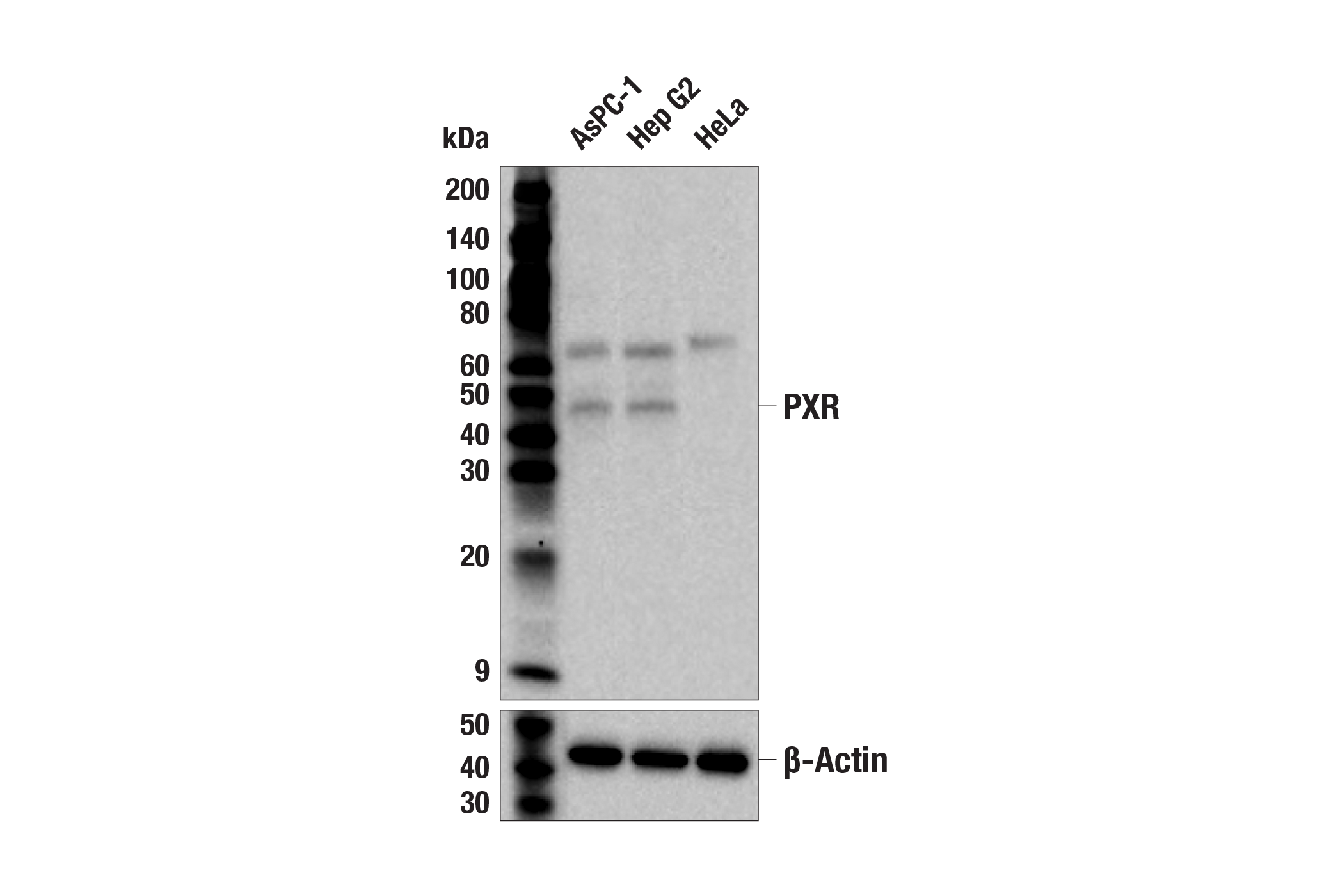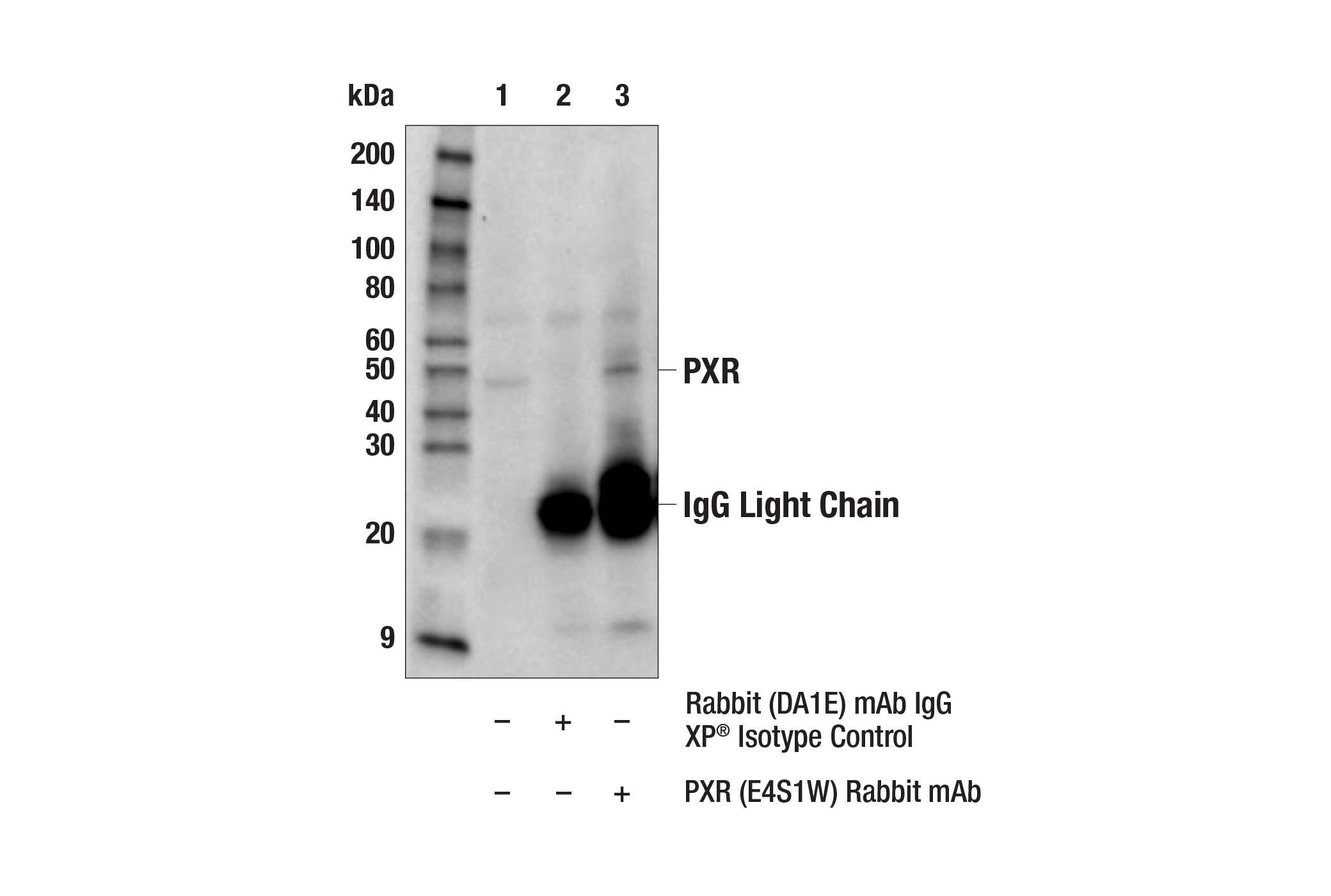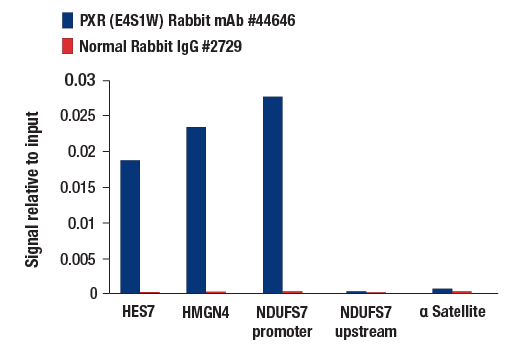WB, IP, ChIP
H
Endogenous
45
Rabbit IgG
#O75469
8856
Product Information
Product Usage Information
| Application | Dilution |
|---|---|
| Western Blotting | 1:1000 |
| Immunoprecipitation | 1:50 |
| Chromatin IP | 1:50 |
Storage
Specificity / Sensitivity
Species Reactivity:
Human
Source / Purification
Monoclonal antibody is produced by immunizing animals with recombinant human PXR protein.
Background
The pregnane X receptor (PXR) is part of the nuclear hormone receptor superfamily and is a master regulator of xenobiotic metabolism (1). PXR was initially described as being activated by pregnanes and inducing expression of the CYP3A family of steroid hydroxylases (2,3). Similar to PPAR and CAR nuclear receptors, PXR utilizes RXR as a heterodimeric partner and controls target hepatic enzyme genes to control liver metabolism in response to a wide variety of drugs (4). However, PXR is strikingly evolutionarily divergent, and the ligand-binding domain only shares around 75% identity across species. Compounds that readily activate human PXR, such as rifampicin, have little activity in rodents (5,6). In humans, in addition to naturally occurring steroids, PXR is activated by numerous xenobiotics, including anti-cancer drugs paclitaxel and tamoxifen, the HIV protease inhibitor ritonavir, and the anti-diabetic troglitazone (5,7-9). PXR has been implicated in numerous conditions, including inflammatory bowel disease, atherosclerosis, and non-alcoholic fatty liver disease (NAFLD) (10-12). PXR plays a protective role in many tumor types and its expression is generally correlated with better prognosis (13-15).
- Kliewer, S.A. et al. (2002) Endocr Rev 23, 687-702.
- Kliewer, S.A. et al. (1998) Cell 92, 73-82.
- Lehmann, J.M. et al. (1998) J Clin Invest 102, 1016-23.
- Waxman, D.J. (1999) Arch Biochem Biophys 369, 11-23.
- Jones, S.A. et al. (2000) Mol Endocrinol 14, 27-39.
- LeCluyse, E.L. (2001) Chem Biol Interact 134, 283-9.
- Dussault, I. et al. (2001) J Biol Chem 276, 33309-12.
- Synold, T.W. et al. (2001) Nat Med 7, 584-90.
- Desai, P.B. et al. (2002) Drug Metab Dispos 30, 608-12.
- Langmann, T. et al. (2004) Gastroenterology 127, 26-40.
- Makishima, M. (2005) J Pharmacol Sci 97, 177-83.
- Lee, J.H. et al. (2008) Mol Pharm 5, 60-6.
- Ouyang, N. et al. (2010) Br J Cancer 102, 1753-61.
- Masuyama, H. et al. (2016) Int J Oncol 49, 1211-20.
- Fujimura, T. et al. (2012) Cancer Sci 103, 176-80.
Species Reactivity
Species reactivity is determined by testing in at least one approved application (e.g., western blot).
Western Blot Buffer
IMPORTANT: For western blots, incubate membrane with diluted primary antibody in 5% w/v nonfat dry milk, 1X TBS, 0.1% Tween® 20 at 4°C with gentle shaking, overnight.
Applications Key
WB: Western Blotting IP: Immunoprecipitation ChIP: Chromatin IP
Cross-Reactivity Key
H: human M: mouse R: rat Hm: hamster Mk: monkey Vir: virus Mi: mink C: chicken Dm: D. melanogaster X: Xenopus Z: zebrafish B: bovine Dg: dog Pg: pig Sc: S. cerevisiae Ce: C. elegans Hr: horse GP: Guinea Pig Rab: rabbit All: all species expected
Trademarks and Patents
Limited Uses
Except as otherwise expressly agreed in a writing signed by a legally authorized representative of CST, the following terms apply to Products provided by CST, its affiliates or its distributors. Any Customer's terms and conditions that are in addition to, or different from, those contained herein, unless separately accepted in writing by a legally authorized representative of CST, are rejected and are of no force or effect.
Products are labeled with For Research Use Only or a similar labeling statement and have not been approved, cleared, or licensed by the FDA or other regulatory foreign or domestic entity, for any purpose. Customer shall not use any Product for any diagnostic or therapeutic purpose, or otherwise in any manner that conflicts with its labeling statement. Products sold or licensed by CST are provided for Customer as the end-user and solely for research and development uses. Any use of Product for diagnostic, prophylactic or therapeutic purposes, or any purchase of Product for resale (alone or as a component) or other commercial purpose, requires a separate license from CST. Customer shall (a) not sell, license, loan, donate or otherwise transfer or make available any Product to any third party, whether alone or in combination with other materials, or use the Products to manufacture any commercial products, (b) not copy, modify, reverse engineer, decompile, disassemble or otherwise attempt to discover the underlying structure or technology of the Products, or use the Products for the purpose of developing any products or services that would compete with CST products or services, (c) not alter or remove from the Products any trademarks, trade names, logos, patent or copyright notices or markings, (d) use the Products solely in accordance with CST Product Terms of Sale and any applicable documentation, and (e) comply with any license, terms of service or similar agreement with respect to any third party products or services used by Customer in connection with the Products.


